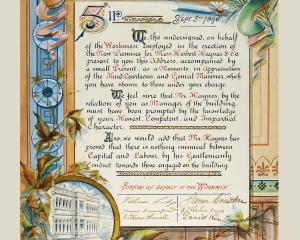
Josiah Wedgwood (1730-1795), the founder of the Wedgwood ceramic company, was born in Staffordshire, England, nearly three centuries ago. In Tristram Hunt’s recent biography, The Radical Potter, Wedgwood is described as an "energetic, intellectually acquisitive, driven and self-promoting character ... [who] wanted to ‘astonish the world all at once"’.
He was elected a Fellow of the Royal Society in 1783 and published five papers in their Philosophical Transactions. Among his many ceramic achievements, he significantly refined and developed a black clay body already in use in the Staffordshire district, which he marketed as black basalt. Wedgwood described it as "a black porcelain of nearly the same properties as the natural stone", although it is technically a high-fired stoneware, rather than a porcelain.

Vases, busts of heroes and statesmen (for display in libraries or on mantelpieces), statuettes, plaques, inkwells, and tea ware were all made in black basalt. A fashion for women to wear white gloves (and even to bleach their hands) when pouring tea on social occasions further increased the demand for tea pots in this material during the early 1770s.
Wedgwood designed and sold portrait medallions in both black basalt and jasperware — another Wedgwood-developed clay body with a matt finish, which was produced in a number of different colours, although blue became the most popular. An early representation of the British diplomat and collector, Sir William Hamilton, was followed by, in Hunt’s words, "popes, kings and queens, scientists and explorers, ancient Greek philosophers and Roman Statesmen ... It was a remarkable, perhaps unrivalled range of figures from the classical past and contemporary public life".
Researchers Robin Reilly and George Savage note that every Wedgwood portrait medallion was made from a relief model, from which an intaglio mould was taken, then a plaster master cast. This was sharpened and re-finished and in turn served as a mould from which the jasperware or basalt medallions were cast.
Tūhura Otago Museum has a small collection of early Wedgwood black basalt and jasperware, most of which came to us as part of the extremely generous bequest of the philanthropist and businessman, Willi Fels (1858-1946). Among these is a group of portrait medallions, containing various Roman and Greek figures, including the poet/writer Menander, the comic poet Posidippus, the poet Hesiod, and Homer, who is credited with being the first person to write down the Iliad and Odyssey epics. A selection of these is exhibited in Tūhura’s People of the World gallery, as Fels himself had a number on display in his London St home, Manono.
Fels described Greece as the country of the dreams of his boyhood. He said that Greek legends and the deeds of Greek heroes were his first introduction to history. He travelled to Greece a hundred years ago, with his sister-in-law. They visited the Olympieion, the Theatre of Dionysus, the Sanctuary of Delphi where the oracle of Apollo spoke, the marble quarries of Mount Pentelikon, and the National Museum.
In the 20th century, Wedgwood’s continuing productions remained commercially popular in Aotearoa. Kirkcaldie and Stains sold Wedgwood in Wellington. In 1915, a visit from a Wedgwood representative was an opportunity for the store to mount a special display including "101 exhibition pieces of ‘old Wedgwood"’ from the firm’s museum. A series of 1924 advertisements in the Wairarapa Daily Times read: "Artistic to the last degree, Black Basalt Pottery is different from everything else in the world. Designed by Master-Craftsmen and of dull flat lambent black, it makes an instant appeal to even those who are not particularly interested in Pottery."
The 1930 bicentenary of Josiah Wedgwood’s birth was also marked in New Zealand. An Observer article reprinted in the Evening Star, was headed "Prince of Potters, The Wedgwood Bicentenary, A Romance of History".
In 1934, Fels spoke about a group of ceramics (including a number of his own that were lent for the occasion) displayed at an evening event for the Association of Friends of the Otago Museum and the Otago Institute, and said that: "The greatest event in the history of the Staffordshire potteries was the advent of Josiah Wedgwood in 1757 in Burslem and in 1769 in Etruria." Their appeal to him is no surprise.
Willi Fels moved to Dunedin from Germany after marrying Bendix and Mary Hallenstein’s oldest daughter, Sara, and he became a managing director in the company established by his father-in-law, which has its 150th anniversary this year.
Fels made an extraordinary contribution to Tūhura Otago Museum in a variety of ways. The Willi Fels Wing on our southwest corner bears his name in recognition of the immense work he put into fundraising for its construction. He was the first chair of the Association of Friends of the Otago Museum, established our first fund dedicated to collection development, and donated items from his personal collection. The museum, and the citizens of Ōtepoti Dunedin, have benefitted greatly from his years here.
Moira White is curator, Humanities, Tūhura Otago Museum.












